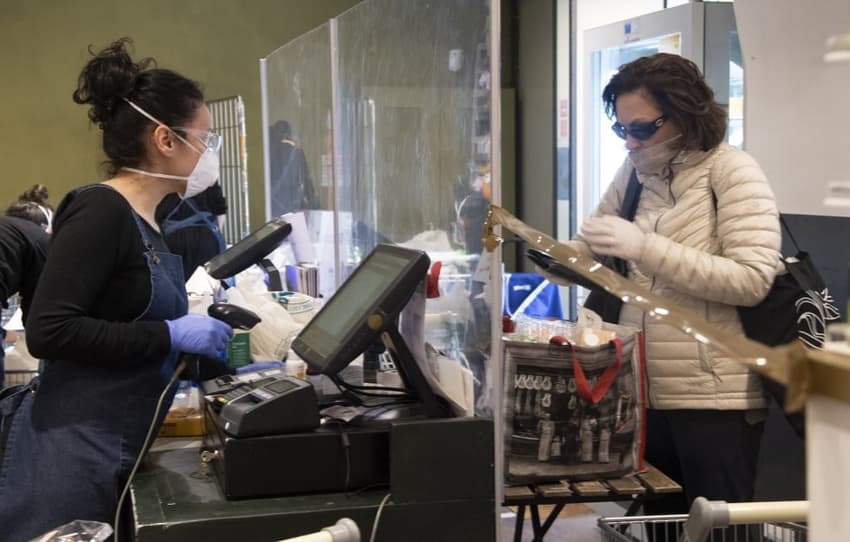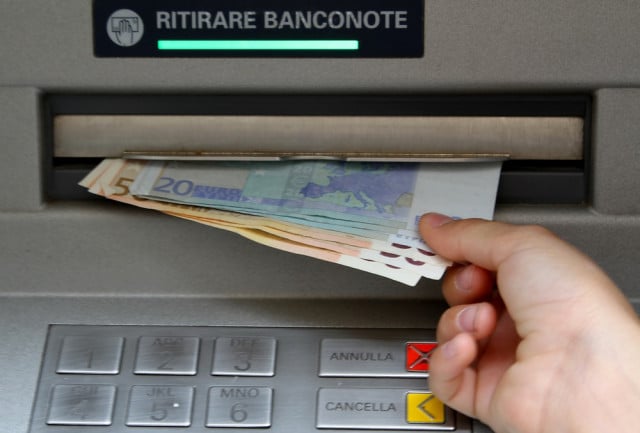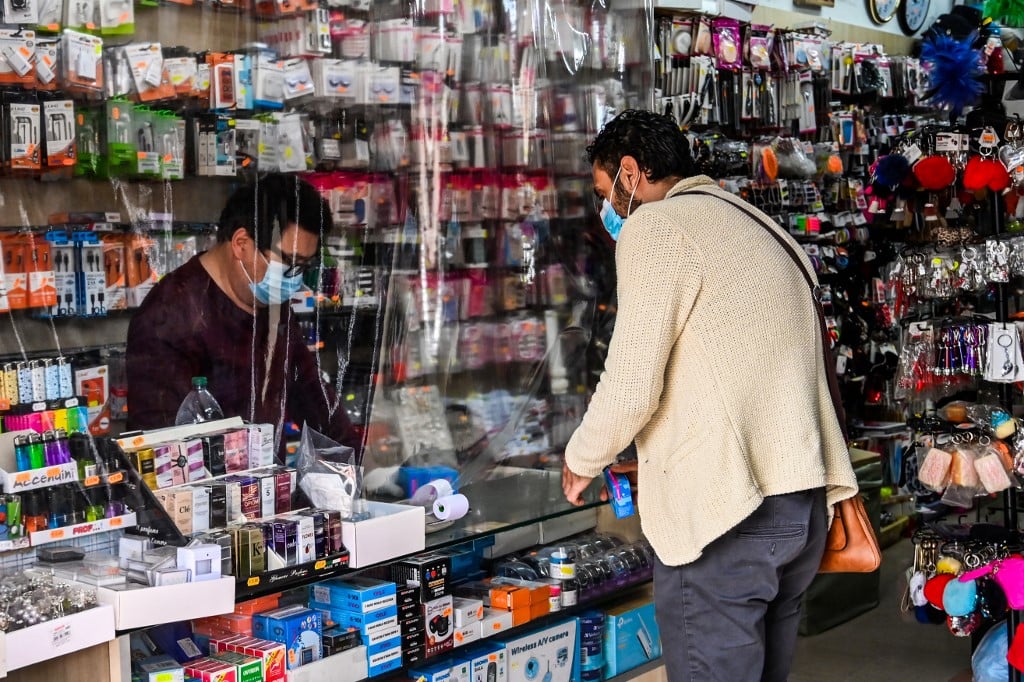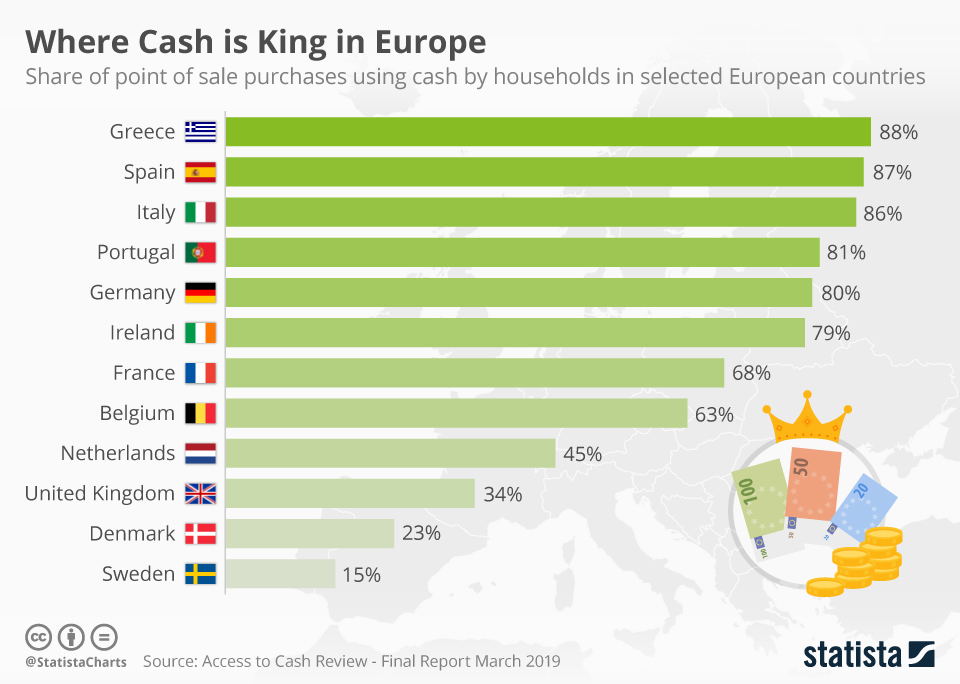'Project Cashless': Could coronavirus push Italy to adopt card payments at last?

As anyone who has tried to pay by card in an Italian shop will know, cashless payments are still not the norm in Italy. But is that about to change under new government plans?
In many other parts of Europe, cashless payments are either very commonplace, or even a requirement in some shops. This is hard to imagine here in Italy, where cash payment is still often the only option.
As anyone who lives in Italy will be aware, you'll need to carry cash for payment at almost any smaller business - just in case.
Of course, those in the centre of major cities are less likely to have this problem, and you can use your card in big chain stores and most tourist-oriented businesses. But otherwise, Italy is noticeably behind many other parts of the continent when it comes to adopting electronic payments.
Even those shops with signs in the window saying they take card payments often actually don't, at least not for small amounts. And you may find electronic payment machines turn out to be malfunctioning with alarming regularity.
This particular feature of Italian life has long bemused and frustrated foreigners in the country. But it could soon be a thing of the past - at least, if the current government gets its way.
Prime Minister Giuseppe Conte is now looking at introducing measures encouraging electronic payments, which the government says is a possible vehicle for contagion, Italian media reports.
On Monday night, immediately after signing Italy's latest emergency decree, Conte met Italy's main electronic payment service providers as part of his Progetto Italia Cashless, or Project Cashless Italy.
 Photo: AFP
He told Italian media on Tuesday the meeting had been “very positive", though didn't give details of plans discussed with the payment companies.
"They too are all aware of the importance for the country of encouraging everyone to use digital payments," Conte stated.
"It will not only mean making the payment system more efficient, more transparent and traceable: it also means laying the foundations for recovering the underground economy, discouraging payments 'in the black'."
Though the coronavirus outbreak is now being cited as a reason to go cashless, Italy's current administration has already been pushing to reduce the number of cash transactons for some time.
Several measures encouraging cashless payments were included in the 2020 budget last November, including the promise of tax incentives for those who pay by electronic - and therefore traceable - means, as authorities try to tackle widespread tax evasion.
The government also stated it would slash the maximum cash payment allowed from the current 3,000 euros down to 1,000 euros by 2022.
But ministers may now be hoping that the public is now more open to switching to electronic payments - either due to hygiene concerns, or after shopping online for the first time during lockdown.
As elsewhere in the world, some Italian shops and businesses had already taken it upon themselves to start asking customers to use contactless payments to avoid handling bills possibly touched by an infected person.
This includes payment via apps in some restaurants, as well as requests for customers in shops to use contactless payment methods.
Photo: AFP
He told Italian media on Tuesday the meeting had been “very positive", though didn't give details of plans discussed with the payment companies.
"They too are all aware of the importance for the country of encouraging everyone to use digital payments," Conte stated.
"It will not only mean making the payment system more efficient, more transparent and traceable: it also means laying the foundations for recovering the underground economy, discouraging payments 'in the black'."
Though the coronavirus outbreak is now being cited as a reason to go cashless, Italy's current administration has already been pushing to reduce the number of cash transactons for some time.
Several measures encouraging cashless payments were included in the 2020 budget last November, including the promise of tax incentives for those who pay by electronic - and therefore traceable - means, as authorities try to tackle widespread tax evasion.
The government also stated it would slash the maximum cash payment allowed from the current 3,000 euros down to 1,000 euros by 2022.
But ministers may now be hoping that the public is now more open to switching to electronic payments - either due to hygiene concerns, or after shopping online for the first time during lockdown.
As elsewhere in the world, some Italian shops and businesses had already taken it upon themselves to start asking customers to use contactless payments to avoid handling bills possibly touched by an infected person.
This includes payment via apps in some restaurants, as well as requests for customers in shops to use contactless payment methods.
 Photo: AFP
This means the predicted gradual shift towards electronic payments "could probably see an acceleration" due to the coronavirus crisis, said Michele Centemero, Mastercard country manager for Italy.
He was commenting on a study released in June by Mastercard which found that, for large retailers, "the penetration of card transactions has grown by 20 percent, contactless has grown and two million Italians have used e-commerce for the first time, an increase of eight percent."
Centemero added that small business owners have also "accelerated towards cashless", because of "a rediscovery of neighborhood shops".
81 percent of Italian consumers surveyed said they felt electronic payments were more hygienic - even though there's no firm evidence that bank notes really do pose a significant risk of contagion.
But even if Italians embrace electronic payments, cash payments look likely to remain a popular option, if not the default, for some time yet.
Mastercard had predicted in 2018 that the percentage of transactions made in cash in Italy would fall to 60 percent by 2023.
But even that remains a long way from widespread adoption of cashless payments on the scale seen in some European countries.
Some studies estimate that up to 86 percent of all point-of-sale payments made in Italy in 2018 were in cash - the third-highest in Europe after Spain and Greece, where the figure is 87 and 88 percent respectively.
This compares to just 15 percent in Sweden and 34 percent in the UK.
Photo: AFP
This means the predicted gradual shift towards electronic payments "could probably see an acceleration" due to the coronavirus crisis, said Michele Centemero, Mastercard country manager for Italy.
He was commenting on a study released in June by Mastercard which found that, for large retailers, "the penetration of card transactions has grown by 20 percent, contactless has grown and two million Italians have used e-commerce for the first time, an increase of eight percent."
Centemero added that small business owners have also "accelerated towards cashless", because of "a rediscovery of neighborhood shops".
81 percent of Italian consumers surveyed said they felt electronic payments were more hygienic - even though there's no firm evidence that bank notes really do pose a significant risk of contagion.
But even if Italians embrace electronic payments, cash payments look likely to remain a popular option, if not the default, for some time yet.
Mastercard had predicted in 2018 that the percentage of transactions made in cash in Italy would fall to 60 percent by 2023.
But even that remains a long way from widespread adoption of cashless payments on the scale seen in some European countries.
Some studies estimate that up to 86 percent of all point-of-sale payments made in Italy in 2018 were in cash - the third-highest in Europe after Spain and Greece, where the figure is 87 and 88 percent respectively.
This compares to just 15 percent in Sweden and 34 percent in the UK.
 You will find more infographics at Statista
You will find more infographics at Statista
Comments
See Also
In many other parts of Europe, cashless payments are either very commonplace, or even a requirement in some shops. This is hard to imagine here in Italy, where cash payment is still often the only option.
As anyone who lives in Italy will be aware, you'll need to carry cash for payment at almost any smaller business - just in case.
Of course, those in the centre of major cities are less likely to have this problem, and you can use your card in big chain stores and most tourist-oriented businesses. But otherwise, Italy is noticeably behind many other parts of the continent when it comes to adopting electronic payments.
Even those shops with signs in the window saying they take card payments often actually don't, at least not for small amounts. And you may find electronic payment machines turn out to be malfunctioning with alarming regularity.
This particular feature of Italian life has long bemused and frustrated foreigners in the country. But it could soon be a thing of the past - at least, if the current government gets its way.
Prime Minister Giuseppe Conte is now looking at introducing measures encouraging electronic payments, which the government says is a possible vehicle for contagion, Italian media reports.
On Monday night, immediately after signing Italy's latest emergency decree, Conte met Italy's main electronic payment service providers as part of his Progetto Italia Cashless, or Project Cashless Italy.

Photo: AFP
He told Italian media on Tuesday the meeting had been “very positive", though didn't give details of plans discussed with the payment companies.
"They too are all aware of the importance for the country of encouraging everyone to use digital payments," Conte stated.
"It will not only mean making the payment system more efficient, more transparent and traceable: it also means laying the foundations for recovering the underground economy, discouraging payments 'in the black'."
Though the coronavirus outbreak is now being cited as a reason to go cashless, Italy's current administration has already been pushing to reduce the number of cash transactons for some time.
Several measures encouraging cashless payments were included in the 2020 budget last November, including the promise of tax incentives for those who pay by electronic - and therefore traceable - means, as authorities try to tackle widespread tax evasion.
The government also stated it would slash the maximum cash payment allowed from the current 3,000 euros down to 1,000 euros by 2022.
But ministers may now be hoping that the public is now more open to switching to electronic payments - either due to hygiene concerns, or after shopping online for the first time during lockdown.
As elsewhere in the world, some Italian shops and businesses had already taken it upon themselves to start asking customers to use contactless payments to avoid handling bills possibly touched by an infected person.
This includes payment via apps in some restaurants, as well as requests for customers in shops to use contactless payment methods.

Photo: AFP
This means the predicted gradual shift towards electronic payments "could probably see an acceleration" due to the coronavirus crisis, said Michele Centemero, Mastercard country manager for Italy.
He was commenting on a study released in June by Mastercard which found that, for large retailers, "the penetration of card transactions has grown by 20 percent, contactless has grown and two million Italians have used e-commerce for the first time, an increase of eight percent."
Centemero added that small business owners have also "accelerated towards cashless", because of "a rediscovery of neighborhood shops".
81 percent of Italian consumers surveyed said they felt electronic payments were more hygienic - even though there's no firm evidence that bank notes really do pose a significant risk of contagion.
But even if Italians embrace electronic payments, cash payments look likely to remain a popular option, if not the default, for some time yet.
Mastercard had predicted in 2018 that the percentage of transactions made in cash in Italy would fall to 60 percent by 2023.
But even that remains a long way from widespread adoption of cashless payments on the scale seen in some European countries.
Some studies estimate that up to 86 percent of all point-of-sale payments made in Italy in 2018 were in cash - the third-highest in Europe after Spain and Greece, where the figure is 87 and 88 percent respectively.
This compares to just 15 percent in Sweden and 34 percent in the UK.
 You will find more infographics at Statista
You will find more infographics at Statista
Join the conversation in our comments section below. Share your own views and experience and if you have a question or suggestion for our journalists then email us at [email protected].
Please keep comments civil, constructive and on topic – and make sure to read our terms of use before getting involved.
Please log in here to leave a comment.